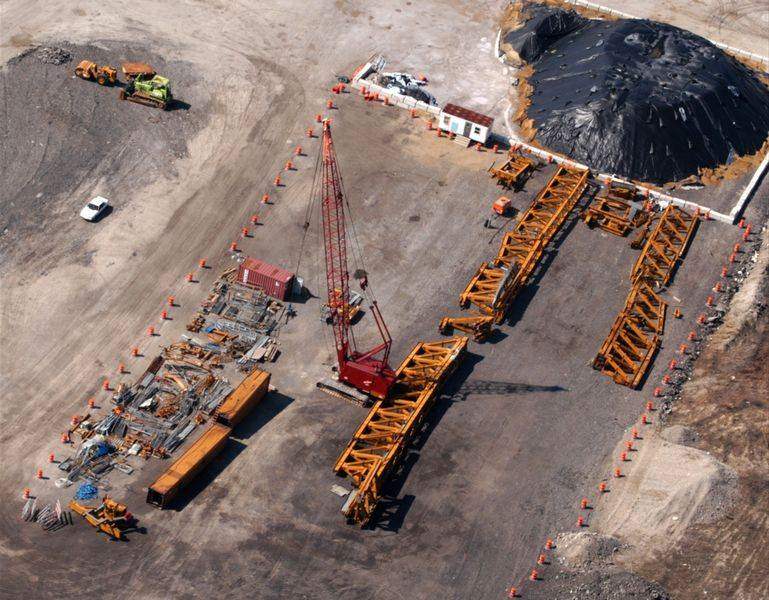
Steel fractures discounted in crane collapse
3/19/2004
Parts of the collapsed crane are placed at a clearing north of the bridge construction site.
Engineers have determined that fractures discovered in steel parts at the top of the collapsed I-280 truss crane were not the cause of the accident, The Blade has learned.
Damage to the steel appears to have been the result of the collapse, said Dr. John Fisher, an engineering professor at Lehigh University, where the metal was sent for analysis.
"They [the cracks] do not appear to be the initiator" of the collapse, Dr. Fisher, who visited the Toledo bridge site last week, said yesterday. "We originally looked at this as one potential possibility, but after careful examination this was not the case."
The analysis centered on pieces of steel that comprise a portion of the overbridge, the part of the truss crane that carried most of the weight of the concrete segments that were used to build each span.

However, Dr. Fisher said the finding does not mean that steel failure has been totally ruled out.
Lehigh engineers have not yet studied a portion of the drive leg of the truss that was sent there for study, he said. The drive leg is considered a critical portion of the truss because of its role in moving the truss from one pier span to the next. The truss was in the process of being moved when it collapsed Feb. 16. The collapse claimed the lives of four men and injured four others.
Fru-Con Construction Corp., the bridge's contractor, acknowledged this week that it is reviewing the quality of the steel used by an Italian firm that made the failed truss. A second truss remains intact at the project's site, although it has not been used since the accident and won't be until it is ruled safe.
"We need to go through the quality-control records for the manufacture of the truss to determine the steel supplier for the various components of the truss," Edwin Neumann, vice president of Fru-Con's civil business division said in a written statement. "This will be part of our investigation and is not yet complete."
Mr. Neumann said it will be another three to four weeks before analytical and forensic testing is completed "to a point that we can begin to pinpoint the cause." He said the Occupational Safety and Health Administration will determine when to make the findings public.
Late last week, three pieces of the top chord of the collapsed truss, along with the drive leg, were sent to Lehigh for study. From a layman's view, the top and bottom chords are the thick horizontal beams that run the length of the truss crane and are connected by diagonal braces.
When the crane is extended - as it was at the time of the collapse - the weight compresses the bottom chord, while pulling, or tensioning, the top chord.
One theory investigators were exploring was that the top cord had failed under the weight.
But Dr. Fisher said it was obvious almost immediately - both from looking at the steel samples at the lab and by measuring the fractures - that the breaks were impact breaks from the collapse, not breaks resulting from fatigue.
"Based on what we've observed, we're not going to pursue these particular fractures with a great deal of optimism," Dr. Fisher said. Still, he said several samples of the steel will be sliced off for further study, and other pieces may be shipped to Lehigh as investigators continue clearing the wreckage.
Jow Rutherford, spokesman for the Ohio Department of Transportation, said he did not know if the fractures were found in the drive leg, as they were in the overbridge pieces sent to Lehigh. But because of its role in moving the truss, he said it made sense to have it analyzed.
Although the work at the Lehigh lab in Bethlehem, Pa., is being paid for by Fru-Con, officials said the results are being shared with OSHA, ODOT, and others. OSHA is leading the investigation and expects to issue a report by mid-August.
ODOT officials have stressed that they are looking at every possible factor and are not ruling out anything, including such issues as human error, the weather, and the equipment.
Next week, investigators may gain valuable information about the collapse from a computer that monitors different aspects of the truss' operation.
Mr. Rutherford said the results will come from the analysis of programming logic controller (PLC) recovered from the accident debris.
The PLC is likened to the "black box" that commercial airliners contain that constantly record flight data that are often helpful in figuring out why a plane crashes.
The devices record things such as side-to-side and up-and-down movements of cranes, as well as information on their weight load and are commonly used on bridges.
A PLC can sometimes provide insight into an accident by revealing what forces were being applied at the time of an accident.